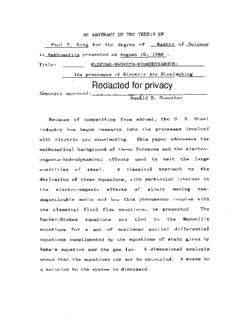
Electro-magneto-hydrodynamics : the processes of electric arc PDF
Preview Electro-magneto-hydrodynamics : the processes of electric arc
AN ABSTRACT OF THE THESIS OF Paul E. King for the degree of Master of Science in Mathematics presented on August 10, 1988 . Title: ELECTRO-MAGNETO-HYDRODYNAMICS: The processes of Electric Arc Steelmaking Redacted for privacy Abstract approved: Ronld B. Guenther Because of competition from abroad, the U. S. Steel industry has begun research into the processes involved with electric arc steelmaking. This paper addresses the mathematical background of these furnaces and the electro- magneto-hydrodynamical effects used to melt the large quantities of steel. A classical approach to the derivation of these equations, with particular interest in the electro-magneto effects of slowly moving non- magnetizable media and how this phenomenon couples with the classical fluid flow equations, is presented. The Navier-Stokes equations are tied to the Maxwell's equations for a set of nonlinear partial differential equations complimented by the equations of state given by Saha's equation and the gas law. A dimensional analysis shows that the equations can not be decoupled. A means to a solution to the system is discussed. ELECTRO-MAGNETO-HYDRODYNAMICS: The Processes of Electric Arc Steelmaking by Paul E. King A THESIS submitted to Oregon State University in partial fulfillment of the requirements for the degree of Master of Science Completed August 10, 1988 Commencement June 1989 APPROVED: Redacted for privacy Professor of Mathematics in charge of major Redacted for privacy Head of Department of Mathematics Redacted for privacy Scho4 Dean of Gra e Date thesis is presented August 10, 1988 "Everything that can be invented has been invented" John H. Duell Director, U. S. Patent Office 1899 I would like to dedicate this work to Mr. Duell, who seems to have the attention of the steel workers of America. I would also like to thank the following people for all the help and support that they have given me while I put together this manuscript. Dr. Ron Guenther who put me in contact with the U. S. Bureau of Mines and guided me through the rough spots. Mr. Tom Ochs, Group Supervisor and Principle Investigator, U. S. Bureau of Mines, Albany Research Center, who introduced me to the topic, gave invaluable information and moral support on countless occasions. My roommates, Ingo Becker and Mark Cocks who helped me to keep my sanity, and the rest of the graduate students in the Math department during the last two years. I especially want to thank my mother who encouraged me and showed me the error of my ways in one section. Lastly, I want to thank Shelley O'Brien, now Shelley King, for her understanding and perseverance during the preparation of this manuscript. TABLE OF CONTENTS INTRODUCTION 1 HISTORY 4 THE EXPERIMENTAL FURNACE 11 THE GOVERNING EQUATIONS 17 A. Hydrodynamics 17 B. Electrodynamics 37 C. The Equations of State 63 A PATH TO THE SOLUTION 68 CONCLUSION 78 BIBLIOGRAPHY 86 LIST OF FIGURES 1. The experimental furnace at ALRC 80 2. Inside the experimental furnace 81 3. The camera setup for data acquisition 82 4. The Faraday cage to protect the electronics 83 5. OSM's 90 ton furnace 83 6. The LECTROMELT "FT" furnace 84 7. The LECTROMELT 400 ton furnace 85 SYMBOLS Here is a list of the symbols used within the following paper, in the order that they appear. This is a complete list with descriptions of what each symbol represents. Because this paper combines fluid dynamics with electrodynamics, some of the standard symbols have been changed to avoid confusion. FLUID FLOW SYMBOLS x = position in fixed coordinate X = position of a fluid particle at time t = 0 = 1i(X,t) = transformation from moving frame to fixed frame = 11(x,t) = inverse transformation p = p(x,t) = fluid density u = u(x,t) = fluid particle velocity F = arbitrary scalar function of x and t V = arbitrary volume element I = arbitrary surface element dV = differential volume element dS = differential surface element n = outward unit normal = mass of a volume element t = stress vector f = extraneous forces per unit mass T = stress tensor V = ( 8 8 8 ) = gradient operator Oxi'ex2,8x3 r = x x. = position vector where xo = x(0) 9 = deformation tensor = kinetic energy 0 = vorticity tensor P = fixed position in a vector field w = curl(u) = vorticity vector = Jacobian matrix 0 = temperature = entropy e = specific internal energy 0 = heat p = pressure cv = heat capacity at constant volume cp = heat capacity at constant pressure C = total entropy U = internal energy h = heat flux vector 5 = identity matrix g = T + p5 = tensor T = dissipation function I, II, III = principle invariants of the deformation C = div(u) A, p = scalar functions of the thermodynamic state (viscosities) ELECTRODYNAMIC SYMBOLS qi = source charge Q = test charge = unit vector pointing from qi to Q F = force vector E = electric field pc = pc(x,t) = charge distribution = flux d = distance i = i(x,t) = current B = magnetic field dl = differential line segment K = surface current density J = volume current density a, b = general vectors v = v(x,t) = charge velocity a = conductivity f = force per unit charge = electromotive force C = closed path b = radius of a ball p = dipole moment a = polarizability P = polarization d = distance vector pp = polarization volume density D = displacement vector field A = magnetic vector potential m = magnetic dipole moment M = magnetization H = magnetic field intensity EQUATIONS OF STATE SYMBOLS cg = gas constant e- = free electron k = Boltzman constant A = ionization energy h = Planck's constant gi = ground state degeneracy = characteristic ionization temperature V = volume 0 = degree of ionization
Description: